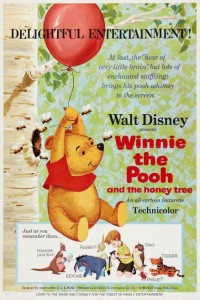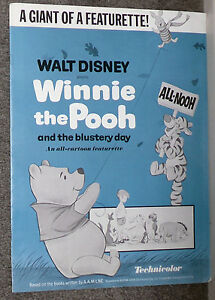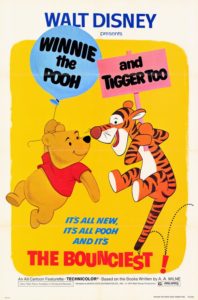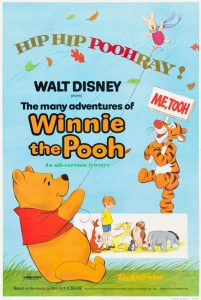
Bedtime stories with his daughters were Walt Disney’s first inspiration for bringing Winnie the Pooh to movie screens. He had memories of his wife, Lillian reading the Winnie the Pooh stories to their daughters, Diane and Sharon.
 This was one of the significant reasons Walt and his artists brought the stories to life in animation. Winnie the Pooh and the “Hundred Acre Wood” residents first appeared in the 1924 book, When We Were Young, written by A.A. Milne and illustrated by E.H. Shepard. This was all very personal to the author, based on his son, Christopher Robin, and how he would play with his stuffed animal “friends.”
This was one of the significant reasons Walt and his artists brought the stories to life in animation. Winnie the Pooh and the “Hundred Acre Wood” residents first appeared in the 1924 book, When We Were Young, written by A.A. Milne and illustrated by E.H. Shepard. This was all very personal to the author, based on his son, Christopher Robin, and how he would play with his stuffed animal “friends.”
The stories were extremely popular, and Pooh and the other characters quickly became beloved.
In 1961, Walt Disney secured the rights to the A.A. Milne stories. Initially planned as a feature-length animated film, the production then changed to a short “featurette” film that would play with one of the studio’s live-action films. Walt felt that with Winnie the Pooh stories not as well-known in the States as they were in the United Kingdom, a featurette would assist with building an audience.
That first featurette was Winnie the Pooh and the Honey Tree in 1966, followed by 1968’s Winnie the Pooh and the Blustery Day (which won the Oscar for Best Animated Short Film) and Winnie the Pooh and Tigger Too (1974).
In 1977, however, the original vision for a feature film would come to fruition when these featurettes were put together, and new animation was produced to “connect” them, along with a new conclusion. It was all “re-packaged” as The Many Adventures of Winnie the Pooh.
 The film, which debuted forty-five years ago, opens, just as the shorts had, with live-action shots of the bedroom of Christopher Robin. Illustrations come to animated life as we are taken inside a storybook, and the Sherman brothers’ iconic “Winnie the Pooh” theme song greets us.
The film, which debuted forty-five years ago, opens, just as the shorts had, with live-action shots of the bedroom of Christopher Robin. Illustrations come to animated life as we are taken inside a storybook, and the Sherman brothers’ iconic “Winnie the Pooh” theme song greets us.
This introduces Pooh, Christopher Robin, and the other familiar friends, such as Piglet, Rabbit, Eyeore, Kanga, Roo, and Owl.
The pages take us to the first story, Winnie the Pooh and the Honey Tree, during which Pooh’s “ever-growing” love of honey finds him expanding to a size, where he becomes lodged in the entrance of Rabbit’s house.
From this tale, pages turn to Winnie the Pooh and the Blustery Day, which takes place on a very windy day, or “Winds-day.” It’s on this stormy day and night that Pooh meets the hyperactive hopper Tigger (who would quickly become an audience favorite), and the bear also dreams about “Heffalumps and Woozles.”
The last story is Winnie the Pooh and Tigger Too, where Rabbit attempts to get Tigger to stop bouncing. This segment is filled with a beautiful moment of character animation, from Disney Legend Milt Kahl, where Tigger, promising he won’t bounce anymore, must stop himself from an enthusiastic bounce, slumps his shoulders, and walks off into the woods.
 Kahl and several of Walt’s famed “Nine Old Men” of his animation team worked on the Winnie the Pooh short films and brought personalities and emotions to each character. Pooh’s childlike wonder and questioning, Rabbit’s officious nature, and Owl’s cluelessness while telling stories are just three wonderful examples.
Kahl and several of Walt’s famed “Nine Old Men” of his animation team worked on the Winnie the Pooh short films and brought personalities and emotions to each character. Pooh’s childlike wonder and questioning, Rabbit’s officious nature, and Owl’s cluelessness while telling stories are just three wonderful examples.
Helping to bring the characters to life was a cast of character actors whose voices have become now so closely aligned with these cherished members of Pooh corner. Disney favorite Sterling Holloway as Winnie the Pooh, John Fiedler as Piglet, Paul Winchell as Tigger, Barbara Luddy as Kanga, and Sebastian Cabot as the narrator, are just some.
Additionally, the Disney studio utilized unique backgrounds that looked less like the full artistry seen in other features and more like a storybook illustration. At times, the characters interact with text on a page. This provided a nice connection to Milne’s source material.
Even with all this thoughtfulness, there were still controversies when the Disney studio first adapted the Winnie the Pooh stories. The biggest of these was how “Americanized” Milne’s treasured stories were, with a primarily American voice cast and the introduction of a new character, who didn’t appear in the book, named Gopher (voiced by comedian Howard Morris).
 This didn’t deter the Winnie the Pooh stories and characters from becoming some of Disney’s most popular and a favorite for generations of audiences through the years.
This didn’t deter the Winnie the Pooh stories and characters from becoming some of Disney’s most popular and a favorite for generations of audiences through the years.
There has been ubiquitous merchandise, including everything from stuffed animals to T-shirts and storybooks (which, at one point, had sales that outperformed Mickey Mouse products). Additionally, Disney has featured Pooh and the characters in several other feature films, including 2011’s Winnie-the-Pooh and 2018’s live-action Christopher Robin, as well as TV shows and appearance in attractions, parades and shows at their theme parks.
While introduced by Milne almost a century ago, and so closely and personally connected with the author, Pooh Bear, Piglet, Tigger, and the rest of the gang are also a large part of the Disney “family” of characters.
Celebrating its 45th anniversary this year, The Many Adventures of Winnie the Pooh may indeed be a compilation of previously released shorts, but the film has become so much more for so many through the years.
Like Milne’s connection to his son, when creating the stories, and Walt’s connection to his daughters, when reading the stories, The Many Adventures of Winnie the Pooh celebrates the precious and wondrous years of childhood.
For more about Disney’s Winnie The Pooh, check out Greg Ehrbar’s columns about Winnie’s recording career.


 Michael Lyons is a freelance writer, specializing in film, television, and pop culture. He is the author of the book, Drawn to Greatness: Disney’s Animation Renaissance, which chronicles the amazing growth at the Disney animation studio in the 1990s. In addition to Animation Scoop and Cartoon Research, he has contributed to Remind Magazine, Cinefantastique, Animation World Network and Disney Magazine. He also writes a blog, Screen Saver: A Retro Review of TV Shows and Movies of Yesteryear and his interviews with a number of animation legends have been featured in several volumes of the books, Walt’s People. You can visit Michael’s web site Words From Lyons at:
Michael Lyons is a freelance writer, specializing in film, television, and pop culture. He is the author of the book, Drawn to Greatness: Disney’s Animation Renaissance, which chronicles the amazing growth at the Disney animation studio in the 1990s. In addition to Animation Scoop and Cartoon Research, he has contributed to Remind Magazine, Cinefantastique, Animation World Network and Disney Magazine. He also writes a blog, Screen Saver: A Retro Review of TV Shows and Movies of Yesteryear and his interviews with a number of animation legends have been featured in several volumes of the books, Walt’s People. You can visit Michael’s web site Words From Lyons at: 






















“The Many Adventures of Winnie the Pooh” was one of the first Disney films our family owned on VHS. I watched it constantly for years until the tape wore out. “Heffelumps and Woozles” was always my favorite scene.
Winnie the Pooh and his stuffed animal friends did not inhabit the Hundred Acre Wood until they appeared in the book “Winnie-the-Pooh” in 1926. Christopher Robin and “Pooh” the Swan are mentioned in the introduction to “When We Were Very Young”, and a stuffed teddy bear named Edward is introduced in the poem “Teddy Bear”, but the stuffed animals and their woodland world are not anywhere in the 1924 book of poetry.
The most ugly aspect of the Disney involvement with A. A. Milne’s animals was the more than 20 years fight with the Stephen Slesinger interests over whether VHS cassettes, DVDs and Video/Computer games constitute “Character Merchandise”. Winnie the Pooh’s special world was contaminated by this fight over profits. It ruins the enjoyment of the Disney versions of the characters for me.
Thank you so much for the clarification about the books, it was difficult to figure out while doing research. Much appreciated!
There was a Shirley Temple television series where the adult Shirley would host and often star in one-hour adaptations of children’s stories. One of them was Winnie the Pooh, performed by the Baird Marionettes. I remembered seeing that as a very little kid, well before the Disney version. Decades later saw in home video; amused to note Pooh was given a folksy Jimmy Stewart voice.
Very faint memory of a babysitter reading the story of Pooh stuck in the rabbit hole, capped by her making a pop sound with her mouth. My brother and I spent the rest of the evening trying to master that effect.
Many years later there was a song, “House at Pooh Corner”, unrelated to the by-then expansive Disney franchise. I remembered that the song referred to the Three-Acre Wood while the films called it the Hundred-Acre Wood.
Somewhere there’s a Punch cartoon of an angry Pooh and friends destroying a television by shoving it down a stairway.
I was always a little nervous about the Disneyland big-head Pooh costume, topped by a “Hunny Pot” that clearly contained the wearer’s head. What if somebody tried to knock it off?
Gopher, from “Lady and the Tramp,” had no business in the Hundred Acre Wood. It would serve Disney right if he became public domain as did the other “Pooh” characters this year.
The late 1980s Pooh cartoons provided a touch of class on Saturday morning.
That was a beaver in “Lady and the Tramp”. Not quite the same character.
i have this fine (& fun) memory of when NBC aired the original shorts as half-hour specials (“Honey Tree,” “Blustery Day”) Great fun!
I commend the desire to post an article on one of my favorite animated films (a month late), but there are a few things here I feel like are worth correcting or clarifying:
– The scene in TIGGER TOO where Tigger sadly walks off upon being told that he had promised never to bounce again while stuck in the tree was actually animated by then-newcomer John Pomeroy (as it was produced years apart from HONEY TREE and BLUSTERY DAY, when most of the animators on the first two shorts had moved onto or were occupied with other projects, it was decided that TIGGER TOO would serve as a good testing ground for the trainees that had joined the studio by the early ‘70s).
– While the reasoning behind Walt’s decision to go with a featurette instead of a feature film at first being that he felt that the “Winnie-the-Pooh” stories were lesser known in America than they were in Britain is undoubtedly more widespread, a more likely reason is that he felt the stories were too low-key and thus, too challenging to adapt in a way that would be palatable to the American film-going audience if the project remained feature-length (they were, after all, popular with American readers beforehand).
I’ve always found the production history of the early Pooh project(s) so fascinating and so “pooh-plexing” as many sources are a tangled web when it comes to explaining it. Maybe a Hyperion Historical Alliance monograph would loosen everything up?
Thanks so much for the clarification about John Pomeroy’s animation. He is another brilliant animator and it’s no surprise that’s his work.
And, I agree, a potential, in-depth study of the Disney Winnie the Pooh projects would be fascinating.
Thanks again!